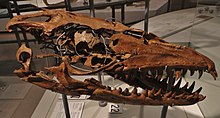
Back Prognathodon Catalan Prognathodon German Prognathodon Spanish پروگناتودون Persian Prognathodon French פרוגנתודון HE Prognathodon Italian プログナトドン Japanese 프로그나토돈 Korean Prognathodon Dutch
| Prognathodon Temporal range: Campanian - Maastrichtian,
| |
|---|---|

| |
| IRNSB R33, the holotype skull of Prognathodon solvayi, the type species of the genus. | |
| Scientific classification | |
| Domain: | Eukaryota |
| Kingdom: | Animalia |
| Phylum: | Chordata |
| Class: | Reptilia |
| Order: | Squamata |
| Clade: | †Mosasauria |
| Family: | †Mosasauridae |
| Subfamily: | †Mosasaurinae |
| Genus: | †Prognathodon Dollo, 1889 |
| Type species | |
| Prognathodon solvayi Dollo, 1889
| |
| Other species | |
| |
| Synonyms | |
(Williston, 1897)
| |
Prognathodon is an extinct genus of marine lizard belonging to the mosasaur family. It is classified as part of the Mosasaurinae subfamily, alongside genera like Mosasaurus and Clidastes. Prognathodon has been recovered from deposits ranging in age from the Campanian to the Maastrichtian in the Middle East, Europe, New Zealand, and North America.[1]
Prognathodon means "forejaw tooth", which originates from the Latin pro- ("earlier" or "prior"), Greek gnathos ("jaw") and odṓn ("tooth"). Twelve nominal species of Prognathodon are recognised, from North America, northern and western Africa, the Middle East, western Europe and New Zealand. Due to the sometimes clear differences between them and the incomplete nature of many of the specimens, the systematics of the genus and which species should properly be considered Prognathodon is controversial. Some species have been assigned to other genera, such as Dollosaurus and Brachysaurana, but this has also been questioned.
Prognathodon is known for its massively built jaws and teeth. Its distinct feeding adaptations have generated much interest in its ecology ever since its discovery, though direct evidence of its diet, such as gastric residues, is rare.[2]
- ^ "Fossilworks: Prognathodon". fossilworks.org. Retrieved 17 December 2021.
- ^ Konishi, Takuya; Brinkman, Donald; Massare, Judy A.; Caldwell, Michael W. (2011-09-01). "New exceptional specimens of Prognathodon overtoni (Squamata, Mosasauridae) from the upper Campanian of Alberta, Canada, and the systematics and ecology of the genus". Journal of Vertebrate Paleontology. 31 (5): 1026–1046. Bibcode:2011JVPal..31.1026K. doi:10.1080/02724634.2011.601714. ISSN 0272-4634. S2CID 129001212.